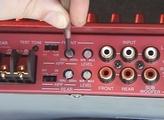Amplifier Power Ratings - Revisited
Normally I wouldn't devote three articles to the same topic but there is no bigger confusion in car audio than power specifications. This is especially true of amplifiers. We've always had the RMS power specification and now we have the even more standardized CEA-2006 rating. Of course neither of them will do any good unless consumers understand what they mean. The focus of this newsletter will be to outline some of the things you should look for when shopping for a car audio amplifier without knowing what all of the specifications mean.
- Rep check - Is the amplifier made by a reputable company with a history of quality products? Does the company have a website and working telephone numbers? If it doesn't then you should stay clear. It's always a good idea to call up the manufacturer and check out their service ahead of time. Do an internet search for the company. I'm amazed when people write and tell me about some piece of equipment from a manufacturer I've never heard of. If you can't find them on the internet then they don't exist as far as I'm concerned. Don't be tempted to save a dollar by buying an inferior amplifier. It's always better to go for the quality product.
- Price check - How does the amplifier stand up in a watts per dollar ratio? Most quality amplifiers will be $0.40 to $0.80 per watt. The higher the wattage, the lower the cost per watt. You're not going to get a true 1,200 watt amplifier for $100. But you CAN get a 50 watt amplifier with "1,200 watts" plastered on the heatsink for $100.
- Fuse check - A quick and dirty way to check the true power output of an amplifier is to take the fuse value of the amplifier (or the sum for multiple fuses) and multiply it by 6 for class A/B amps or 10 for class D amps (higher efficiency). This is by no means an accurate way to judge power but it will tell you if your amp is even close to it's specifications. For example, if a class A/B "1,200 watt" amplifier has a fuse value of 25 amps then you can take 25*6 and get 150. So this "1,200 watt" amplifier is more in the range of 150 watts.
- Gut check - Your body is smarter than you think. Listen to what your gut instinct tells you. Look at the amplifier, feel it's weight and build quality. Does this seem to be what it says? Compare it to other amplifiers with similar power ratings. Which do you think is the better amplifier? Do you sense that the salesman is trying to push something on you? If it doesn't pass the gut check then it's time to walk away and find out more facts on this amplifier.
Doing those four quick checks will save you a lot of headaches when shopping for a car audio amplifier. Just make sure you follow them and don't let your desire for a "bargain" lead you into making the wrong choice.
Related articles:
Cheap Amps, Good Specs. What to believe?
Power Specifications for Amps and Speakers

You may also be interested in How to Install Your Own Car Stereo System . It covers many topics including in depth car audio amplifier installation. Click here.
Back to the Newsletter Archives Index